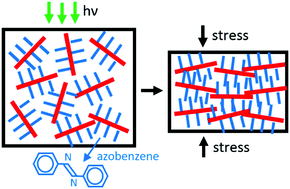Modeling of the photo-induced stress in azobenzene polymers by combining theory and computer simulations
Abstract
It has been shown recently that the photo-induced deformations in azobenzene-containing polymers of a side-chain architecture can be explained by means of the so-called orientational approach. The explanation is based on the following sequence of steps: (i) reorientation of azobenzenes under illumination, (ii) reorientation of the polymer backbones coupled mechanically to azobenzenes, and (iii) development of large stress in a material. Step (i) is based on the angle selective absorption of the azobenzene chromophore, which is a well established fact. Step (iii) has been validated in a series of recent theoretic studies in an infinite coupling limit. Concerning step (ii), in a real material, the backbone–azobenzene coupling will be always finite, resulting in a decrease of the effective torque sensed by the backbones and in a time delay in their reorientation. To study the relevance of these effects in detail, we perform coarse-grained molecular dynamics simulations of side-chain azobenzene-containing oligomers in bulk at conditions close to the glassy state. The focus is on the dynamical properties of such a system and on its response to the illumination, with the latter modeled either as an orientation potential applied to the azobenzenes or via their stochastic photo-isomerization. By matching the amount of light-induced stress evaluated in both cases, we obtained the equivalent orientation potential as a function of the illumination intensity and the system density.



 Please wait while we load your content...
Please wait while we load your content...